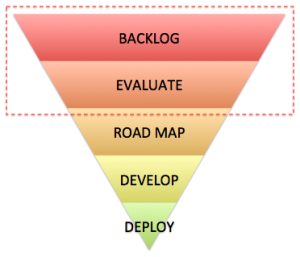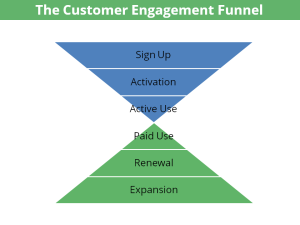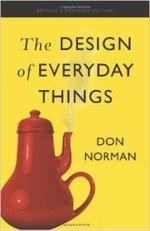This page outlines my approach to driving user adoption and retention using a data-driven approach, based on my experiences at Atlassian, Heroku and as mobile project manager. Data-driven decision making won’t get you far without a deep understanding of your customer and product space, but is a hot topic and critical supplement to traditional user-centric UI/UX strategies. I’m particularly interested in how tracking of in-app behavior enables developers to systemically refine their product UX and avoid some common strategic mistakes:
Product Management
A few of my main principles for successful data-driven product management:
- Build Shared Vision – A product manager’s goal is to help their company to agree on a single direction and set of priorities. My favorite product managers consider themselves primarily as a communication channel, and outsource product decisions to the right people in the company, while still maintaining responsibility for collating and informing the teams on their options and tradeoffs. A PM’s goal is to educate, provide background, and independently resolve differences in direction by putting those people together. I can test the success of this by looking for shared brain state across the team, where everyone agrees on the decision-making process and feels bought-in.
- Be Metrics-Driven – Online businesses which track their user behavior scientifically have an amazing opportunity to engineer their way to growth and profitability. This requires building a suite of user metrics including lifetime value, cost of acquisition, net promoter score and funnel cohorts. Where applicable, I like to instill metrics into every team and every major product change, from your long-term strategy down to the quarterly roadmap and user stories.
- Retention > Growth – I’ve found that improving customer retention is almost always more valuable than improving growth, because retention is a much stronger driver of revenue. B2B businesses in particular benefit from optimizing their onboarding process and retention because they tend to spend so much more per visitor. A product manager who can improve retention will enable their marketing and sales teams to outspend the competition and invest more effort in making their customers successful. The holy grail of retention is negative customer churn, where your existing customer base spends more over time through expansion revenue than you lose from departing customers.
- Systemize Feedback – Customer feedback categoriized depending on whether it’s quantitative or qualitative. Qualitative sources include direct customer phone and email discussions, customer advisory group input, plus internal sales and support channel feedback. Quantitative sources include customer surveys incorporating net promoter scores, and data analysis via a data warehouse with feature tracking.
- Go Lean – Consider how you can validate potential product work quickly. Your toolbox includes product mockups, painted door tests and hypothetical blog posts. I’m a fan of pre-writing product announcements that can be shared internally and with real customers for validation. On the validation side, I also prefer to pitch feature work with both product metrics and personas. Major features may benefit from kicking off with real beta tester customers as ‘feature patrons’, so that I can be sure at least one customer will be happy with the result.
Product Design
Some of my principles for building products to maximize customer satisfaction and revenue:
- Guide Users – Always subtly guide users towards the most valuable next steps for them in your conversion funnel. A well thought-out customer engagement funnel should inform your designing your user flow and vice versa.
- Self Service Philosophy – Products with low barriers to adoption should take a strong self-service approach, especially around user onboarding and support. This self-service approach can include online sales material, public pricing, a freemium tier, signup-free demonstration instances, comprehensive online help, contextual in-app suggestions, plus templates and built-in example content to help scale your sales and support. On the flip side, if your product requires considerable upfront investment in order to be successful, eg integration or customization, then you may be more successful under a professional services model.
- Communicate Business Value – Build your product to clearly communicate business value and end results to your users. This will help potential customers to champion your product internally through demonstrations and internal sales material will reduce your cost of sales. Enabling end users to showcase their results to their management , such as number of actions completed, can also boost your retention and provide opportunities for viral user growth.
- A/B Test – Once you have the user volume and basic product/market fit, you should investing in scaling your success through experimentation. A/B and multivariate testing is especially useful for refining your user interface and customer onboarding process. It’s easy to make a beautiful interface when you start off with very limited functionality, but many designs get bogged down incrementally as they add in both more features and more advanced functionality. If you’re not constantly testing refinements , then you’re missing out on compounding interest in improvements.
- Refine Your Funnel – Embed contextual messaging and feedback forms into your product interface. Many improvements to your conversion funnel come through preventing users from falling out when they hit a roadblock. This is often as simple as popping up unobtrusive guidance whenever a user hits a known problem.
- Integrate & Customize – Enable B2B users to customize and integrate their application into the rest of their business. The single best feature for many customers is the ability to develop any feature, via an API, plugin or integration point. Openess and integration offer an easy path for relatively new market entrants to focus on becoming best-of-breed in a narrow target market, since they can outsource other product areas, rather than needing to deliver a complete product suite at once.
Favorite Product Reads
A selection of my favorite product-related books:
- Crossing the Chasm – A great overview of the challenges of broad market adoption, covering how to establishing product fit for early adopters and selectively expand out to a broader audiences.
- The Innovator’s Dilemma – A strategic overview of the process of technological market disruption.
- Blue Ocean Strategy – Excellent read on market positioning and how to avoid competition.
- The Art of the Start – An entrepreneurial guide to starting and growing a tech company.
- The Design of Everyday Things – An insightful read on design principles, including practical examples of how constraints and human psychology can help you to guide users.
Questions or feedback? Just say hello on Twitter at @davidsoul or get in touch.


